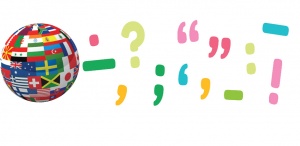Language/Multiple-languages/Grammar/Punctuation-of-many-languages
Marks
Most Common
| Vai | Latin | Greek | Cyrillic
Georgian Hebrew |
Armenian | Ge'ez | Arabic | Devanagari | Bengali
Telugu Tamil Gujarati Gurmukhi Malayalam Kannada Oriya |
Sinhala | Thai | Chinese | Korean | Japanese | |
|---|---|---|---|---|---|---|---|---|---|---|---|---|---|---|
| comma | ꘍ | , | , | , | , | ፣ | ، common
⹁ Sindhi |
, | , | , | (none) | , | , horizontal
、vertical |
、 |
| period | ꘎ | . | . | . | ։ | ። | . common
۔ Urdu |
। common
. Marathi |
। common
. alternative |
. new
෴ old |
(space) | 。 | . | 。 |
| question mark | ꘏ | ? common
¿...? Spanish |
; | ? | ՞ | ፧ | ؟ | ? | ? | ? | ? | ? | ? | (period as formal)
? informal |
| exclamation mark | ꘎꘎ | ! common
¡...! Spanish |
! | ! | ! | ! | ! | ! | ! | ! | ! | ! | ! | ! |
| parentheses | ( ) | ( ) | ( ) | ( ) | ( ) | ( ) | ( ) | ( ) | ( ) | ( ) | ( ) | () | ( ) | () |
| colon | : | : | : | : | : | ፥ | : | : | : | : | : | : | : | : |
| semicolon | ; | ; | ‧ | ; | ; | ፤ | ؛ | ; | ; | ; | ; | ; | ; | ; |
Note:
- Puctuation in Japanese and Chinese are full-width
- Question mark in Greek and period in Armenian scripts looks like semicolon and colon in Latin script, but they have different codes in computers.
Quotation marks
Some of them have alternatives
| language | primary | secondary | spacing |
|---|---|---|---|
| English, United Kindom
Scottish Gaelic Welsh |
‘…’ | “…” | English: 1–2 pt
Welsh: 1–2 pt |
| Afrikaans
Chinese, China English, United States English, Canada Esperanto Filipino Hindi Indonesian Irish Interlingua Maltese Portuguese, Brazil Thai |
“…” | ‘…’ | English: 1–2 pt
Chinese: fullwidth Irish: 1–2 pt |
| Lao
Vietnamese |
“…” | ||
| Finnish
Swedish |
”…” | ’…’ | |
| Bosnian | ”…”
„…” |
’…’ | |
| Dutch
Hebrew |
„…” | ‚…’ | |
| Serbian | „…” | ’…’ | |
| Croatian | „…” | ‘…’ | |
| Polish | „…” | «…»
»…« |
|
| Romanian | „…” | «…» | none |
| Hungarian | „…” | »…« | |
| Czech
German Icelandic Slovak Slovene Sorbian |
„…“ | ‚…‘ | |
| Bulgarian | „…“ | ’…’
‘…’ |
|
| Macedonian | „…“ | ’…‘ | |
| Albanian | „…“ | ‘…’ | |
| Estonian
Georgian Lithuanian |
„…“ | Georgian: none | |
| Amharic
Azerbaijani Basque French, Switzerland German, Switzerland Italian, Switzerland Romansh Tigrinya Turkish |
«…» | Arabic: optional | |
| French | « … » | “…”
« … » |
¼ em |
| Belarusian
Catalan Greek Italian Occitan Portuguese, Portugal Spanish |
«…» | “…” | Catalan: none |
| Russian
Ukrainian Uzbek |
«…» | „…“ | Russian: none
Ukranian: none |
| Norwegian | «…» | ’…’ | |
| Arabic
Armenian Kazakh Khmer Latvian Mongolian Cyrillic Pashto Persian Uyghur |
«…» | Arabic: optional | |
| Danish | »…«
„…“ |
›…‹
‚…‘ |
|
| Chinese, Hong Kong
Chinese, Taiwan Japanese |
「…」 ﹁ |
『…』 ﹃ ﹄ |
Chinese: fullwidth |
| Korean, South Korea | 『…』
﹃ |
「…」
﹁ |
|
| Korean, North Korea
New Tai Lue Tai Le Tibetan |
《…》 | 〈…〉 | |
| Lojban | lu … li'u |
Special
| note | name | usages |
|---|---|---|
| 『 』 「 」 | title marks in Japanese | to indicate titles of books, movies, etc. |
| 《 》 〈 〉 | title marks in Chinese | to indicate titles of books, movies, etc. |
| ♪ | musical note in Japanese | to indicate lyrics in a sentence |
| ¿ | inverted question mark in Spanish | to indicate the begining of an interrogative sentence or phrase |
| ¡ | inverted exclamation mark in Spanish | to indicate the begining of an exclamatory sentence or phrase |
| 、 | enumeration comma in Chinese (PRC) and Korean (North Korea) | to enumerate items |
| ‧ | partition sign in Chinese and enumeration comma in Korean (South Korea) | to separate characters in non-Han personal names in Chinese; to enumerate items in Korean |

